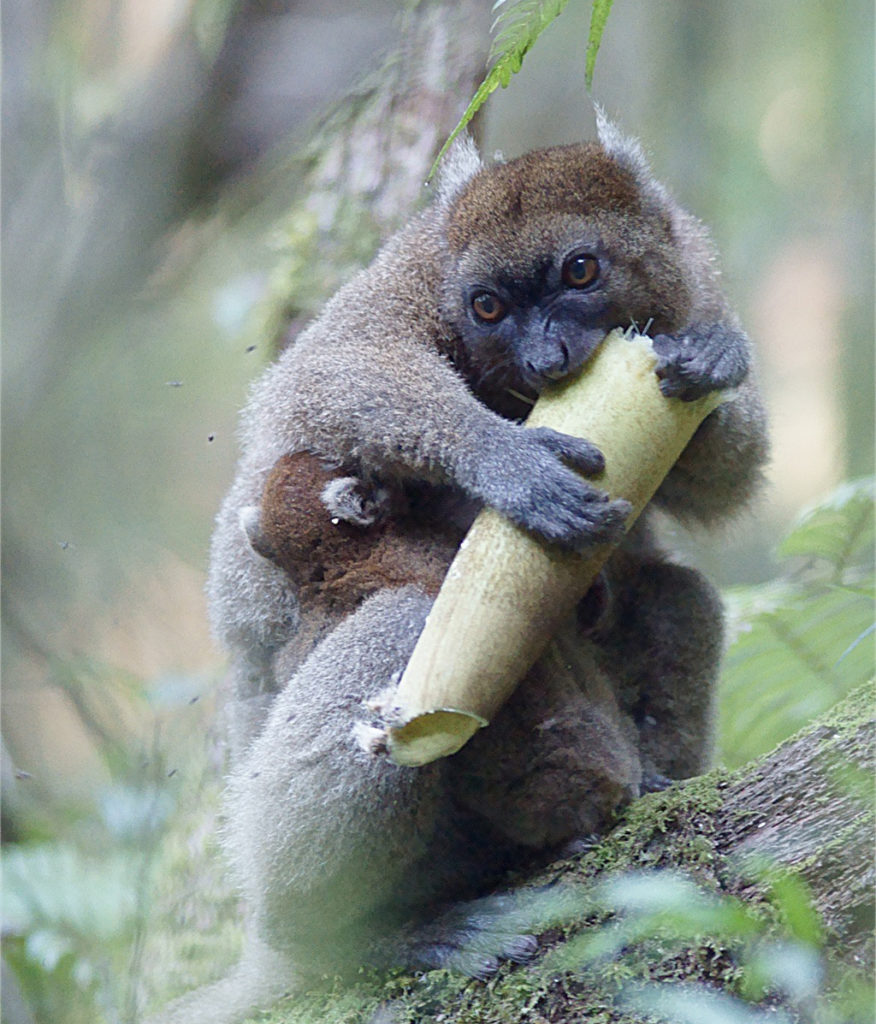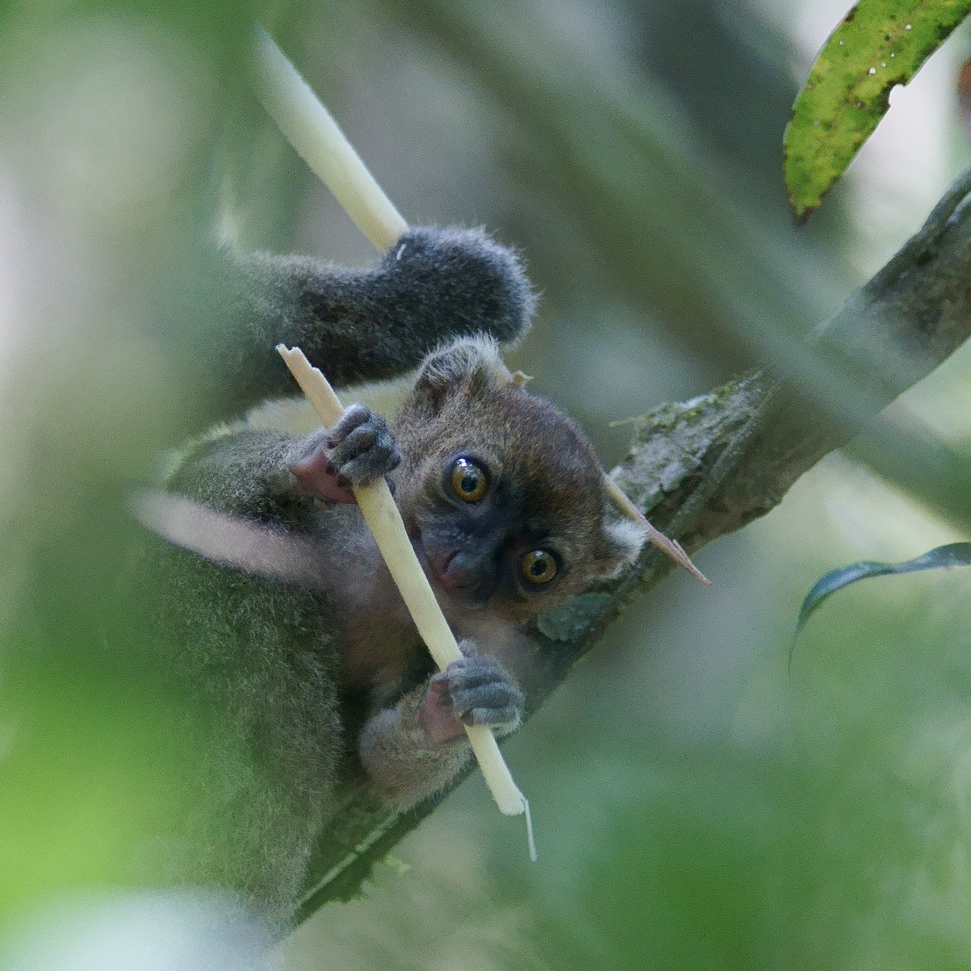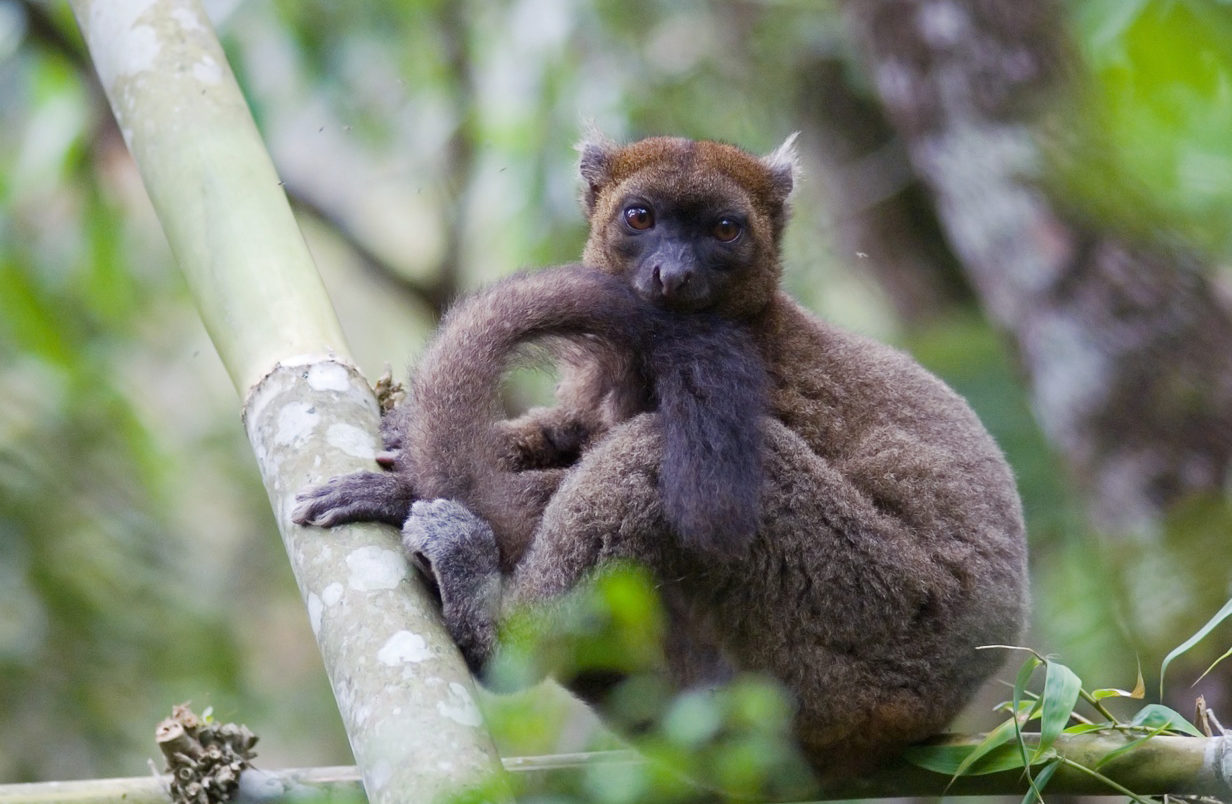
Climate change threatens the survival of Madagascar’s bamboo lemurs
Daisy Dunne
10.26.17Daisy Dunne
26.10.2017 | 5:00pmClimate change could threaten the food supply of bamboo lemurs, new research finds, leaving the animals vulnerable to starvation.
The greater bamboo lemur is a critically endangered primate that lives deep in the forests of Madagascar. There are only around 500 greater bamboo lemurs left in the wild. Much like giant pandas, the animals survive on a diet consisting solely of bamboo.
However, climate change could threaten the feeding habits of these unique animals, the study author tells Carbon Brief.
Rising temperatures could lead to a prolonged and more intense dry season on the island, the research finds, which could alter the availability of fresh bamboo shoots, leaving only tougher, less nutritious options that wear down the lemurs’ teeth.
Bamboozled
The new study, published in Current Biology, is the first to investigate how climate change could threaten the survival of bamboo lemurs.
To do this, the researchers first collected fossils of bamboo lemurs from across Madagascar in order to examine their teeth. This showed the researchers the extent to which the lemurs have become “bamboo specialists”, explains study author Prof Jukka Jernvall, an evolutionary biologist from the University of Helsinki. He tells Carbon Brief:
“Bamboo is a very special kind of diet; hard to chew, difficult to digest, toxic, but there is plenty of it where it grows. Few species have evolved to survive on bamboo, but those that have, have very little competition.”
Chewing bamboo requires “highly complex” teeth with many ridges and furrows. These features make it easier to grind down and chew through tough and woody bamboo.
To study the morphology of the lemurs’ teeth, the researchers used high-resolution dental complexity, a technique which is based on how Geographic Information Systems (GIS) computer software maps the peaks and troughs of mountain ranges. Jernvall says:
“In GIS analysis, the tooth shapes analysed are basically like miniature mountains. Greater bamboo lemur teeth are complex, and the ‘landscape’ looks therefore like rough badlands. These rough surface features are needed to grind the fibrous bamboo.”
The figure below shows how the teeth of bamboo lemurs (top left) compare to those of other bamboo specialists, such as the giant panda (middle left) and the red panda (bottom left), as well as generalist plant-eating mammals, which include the brown lemur (top right), the brown bear (middle right) and the raccoon (bottom right). In the figure, a multitude of colour is used to show how bamboo specialists have more complex and jagged teeth than generalised feeders.
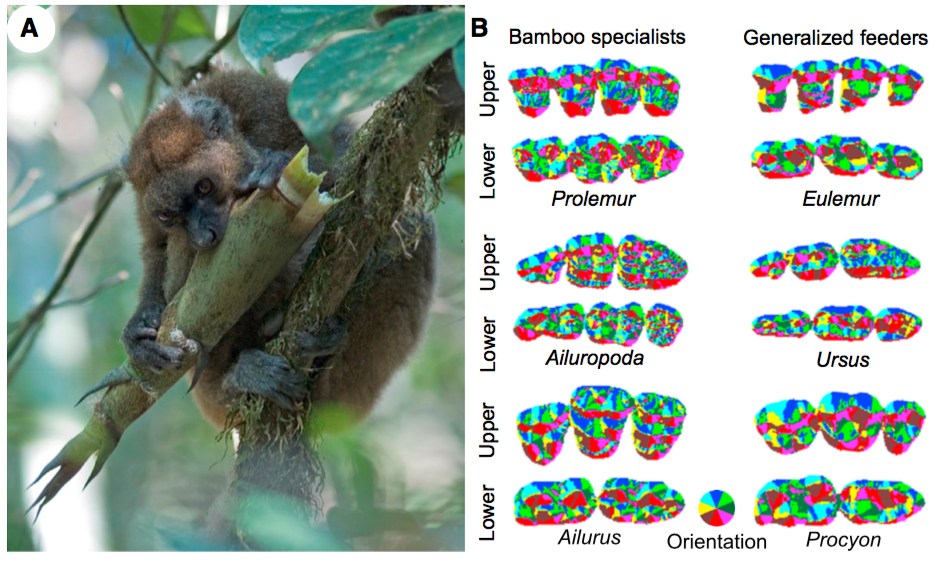
A shows a greater bamboo lemur feeding on a bamboo shoot. Credit: Jukka Jernvall. B shows how the teeth morphology of bamboo lemurs (top left) compare to those of other bamboo specialists, which include the giant panda (middle left) and the red panda (bottom left), as well as generalist plant-eating mammals, which include the brown lemur (top right), the brown bear (middle right) and the raccoon (bottom right). A multitude of colour is used to show how bamboo specialists have more complex and jagged teeth than generalised feeders. Source: Eronen et al. (2017)
Chewing the culm
In order to find out more about how the lemurs alter their feeding habits with the changing seasons, the research team observed a group of lemurs living in Madagascar’s Ranomafana National Park for 18 months.
They found that, during the park’s rainy season, the animals prefer to eat fresh bamboo shoots, which are nutritious and easy to chew.
However, during the dry season, there are no new bamboo shoots are available. Instead, the animals are forced to switch to eating bamboo trunks, otherwise known as “culm”.
Culm is much tougher and less nutritious than bamboo shoots and, if eaten over long periods of time, can cause the animals’ teeth to become worn down.
To assess the impacts of eating culm for long time periods, the researchers used historical climate data to create a map (below) showing how the length of the dry season varies in different parts of Madagascar.
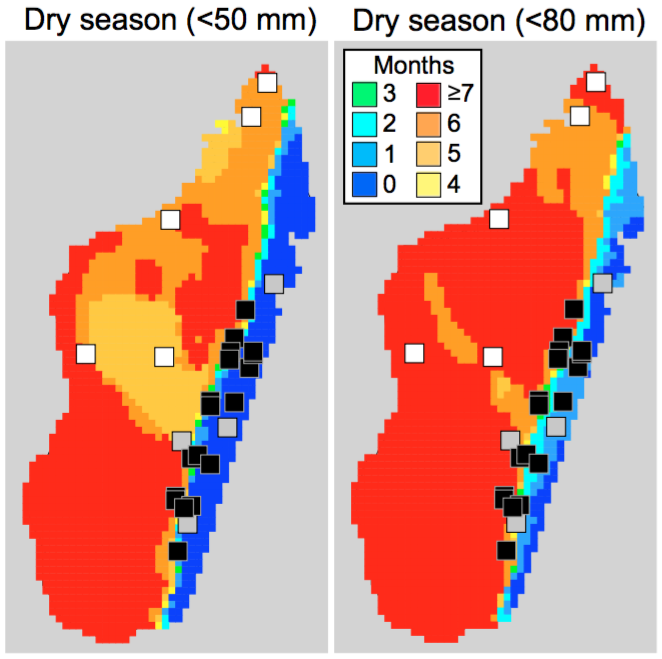
A comparison of the length of the dry season in different parts of Madagascar and the locations of live greater bamboo lemur populations (black squares), historically recorded populations (grey squares) and fossils (white squares). Colour is used to indicate dry season length, with blue showing zero months, orange showing five to six months, and red showing seven or more months. The period of the dry season with less than 50mm of rainfall a month (left) is compared with period with less than 80mm of rainfall a month (right). Source: Eronen et al. (2017)
The maps shows that, on the eastern coast of the island, the dry season is fairly short, lasting just one to two months (shown in blue). This is the part of the island where bamboo lemurs currently live (black squares).
However, in the central, west and southern parts of the island, the dry season lasts a lot longer, spanning more than seven months in some areas (shown in red). In these parts of the island, fossils of bamboo lemur have been found (white squares), but no live lemur populations have been spotted in the area.
This suggests that bamboo lemurs have been driven to extinction in areas with prolonged dry seasons because of the lack of nutritious food.
Hard to swallow
![]()
For the final part of the study, the researchers modelled how global warming could affect the climate of Madagascar.
They find that, even if greenhouse gas emissions peak in 2020 (a scenario known as RCP2.6), climate change could have a profound impact on the island’s conditions.
Namely, climate change is likely to cause the dry season to become longer and more intense across all parts of the island. “These analyses indicate that regions in which P. simus [greater bamboo lemur] are currently found are projected to experience precipitation patterns more comparable to those in the regions in which P. simus has gone extinct,” the paper notes.
This could force bamboo lemurs to spend more time eating culm, which could ultimately cause the animals to starve, Jernvall says:
“The new threat identified in our study is that even if it might look like nothing changes, bamboo lemurs may be in trouble. If the dry season gets just a bit longer or dryer, bamboo lemurs have to survive on bamboo culm a bit longer. This could mean poorer health and faster wear of teeth. Together with overall habitat destruction, and even hunting, the lemurs will have harder time to find suitable places to live.”
These threats may also affect other bamboo lemur species, he adds, including a species known as the golden bamboo lemur. As of 2014, there were five species and three subspecies of bamboo lemurs recognised. However, despite their shared namesake, not all of these species rely on a diet made up exclusively of bamboo.
Looming problems
The seasonal changes associated with climate change could also affect the lemurs’ ability to reproduce, says Dr Giuseppe Donati, a primatologist from Oxford Brookes University, who was not involved in the study. He tells Carbon Brief:
“[The research] implies that high quality resources are only seasonally available and the lemurs have to synchronise their reproductive cycle to make sure that offspring weaning occurs when there is enough high quality food in the forest. It comes without saying that even slight changes in the duration of the seasons may have an effect on the tree phenologies and ultimately on lemurs’ survival.”
However, his previous research suggests that greater bamboo lemurs may be able to adapt to the challenges associated with climate change by switching to other sources of food.
“Although they are known to be less specialised than greater bamboo lemurs, other bamboo lemur species have been considered specialists for a long time but now they have been seen to thrive in areas where there is no bamboo. In the south of Madagascar, our team has worked on southern bamboo lemurs and found that they spend most of their feeding time grazing grass. So there is a need to understand the full behavioural and ecological flexibility of the lemurs before reaching firm conclusions about their ability to survive climate change.”
Tackling climate change on a global scale would be the best way to ensure the long-term survival of the remaining bamboo lemurs in Madagascar, adds Jernvall.
“Climate predictions help to identify the best regions to build bamboo corridors to connect the isolated [lemur] populations left, and expand their habitats to regions where the conditions are not changing so fast. This could be done also outside the protected areas.
“Ultimately, of course, we have to mitigate the climate change and minimize the land use changes or there is nowhere to go in the end. Madagascar, and the world, would be a less diverse place if specialists such as bamboo lemurs would disappear.”
Eronen, J. T. et al. (2017), Feeding ecology and morphology make a bamboo specialist vulnerable to climate change, Current Biology, http://www.cell.com/current-biology/fulltext/S0960-9822(17)31248-4


